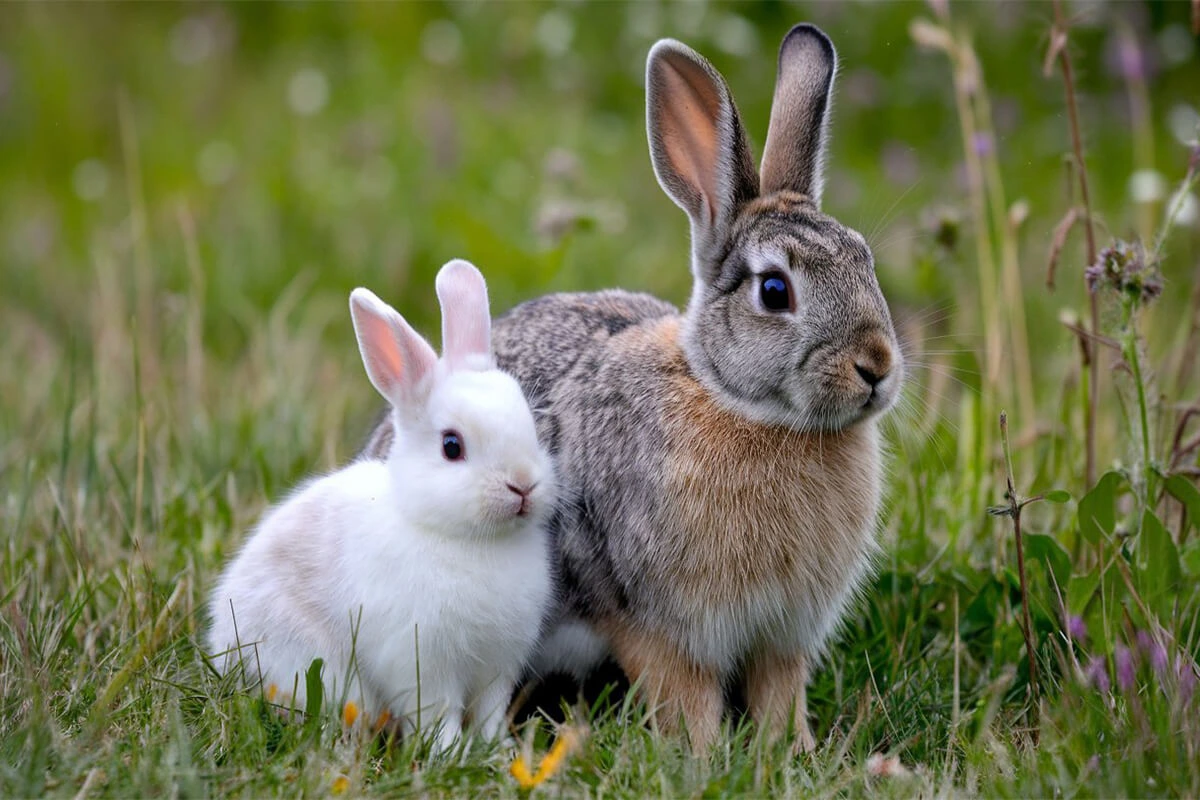Many people use the term “bunny vs rabbit” interchangeably, but they don’t mean exactly the same thing. While both refer to the same species, “rabbit” is the proper scientific name, while “bunny” is more of an informal, affectionate term. Some people assume that bunnies and rabbits are two different animals, but that’s not the case. The confusion often comes from the way these words are used in different contexts, especially when referring to young rabbits or pet names.
Understanding the difference between a bunny and a rabbit is important, especially for pet owners and animal lovers. Rabbits have specific needs, behaviors, and lifespans that vary depending on their breed and environment. Whether you’re thinking about adopting a pet rabbit or just want to learn more about these fascinating animals, knowing these distinctions can help you make informed decisions.
In this article, we’ll explore ten fascinating facts about bunnies and rabbits, covering key differences, behavior, lifespan, pet care, and fun facts. You’ll discover why rabbits thump their feet, what “binkying” means, and how different rabbit breeds vary in size and personality. By the end, you’ll have a better understanding of these lovable creatures and the truth behind the “bunny vs rabbit” debate. Let’s dive in!
Bunny vs Rabbit: Are They the Same?
Definition and Origin of the Terms “Bunny” and “Rabbit”
The words “bunny” and “rabbit” might seem interchangeable, but they have different origins and meanings. The word “rabbit” comes from the Middle English term rabet, which evolved from the Old French rabbotte. Historically, “rabbit” referred specifically to young members of the species, while the term “coney” was used for adult rabbits. Over time, “rabbit” replaced “coney” as the preferred term.
The word “bunny” has a different history. It originally referred to a young or small animal and wasn’t exclusively linked to rabbits. In the past, people used “bunny” as a term for baby squirrels and other small, furry creatures. Eventually, it became a popular way to describe baby rabbits, especially in children’s stories and everyday conversation. Today, “bunny” is more of a cute, affectionate nickname rather than a scientifically accurate term.
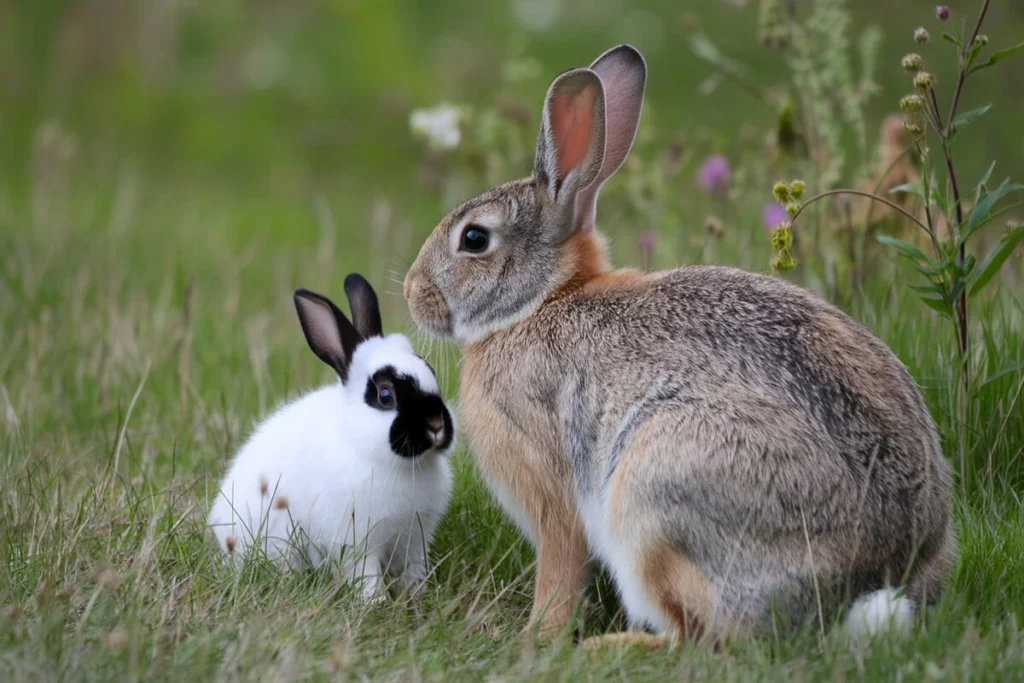
Common Misconceptions About the Two Terms
Many people believe that bunnies and rabbits are two different animals, but that’s not true. A bunny is just a young or small rabbit, and the term is often used informally. Some even think that “bunnies” stay small forever, leading to misunderstandings when they adopt a pet bunny expecting it to remain tiny. In reality, all baby rabbits grow into adult rabbits, and their size depends on their breed.
Another misconception is that “bunny” refers only to domesticated rabbits, while “rabbit” is used for wild ones. However, both wild and domestic rabbits belong to the same species, Oryctolagus cuniculus, though there are many different breeds. The term “bunny” is simply a casual way of referring to them, whether they live in the wild or as pets.
Some people also believe that hares and rabbits are the same animals and that “bunny” refers to both. However, hares belong to a different genus and have distinct characteristics, such as longer legs, larger ears, and a more solitary lifestyle.
Scientific Classification: Lagomorphs and Mammals
Rabbits belong to the animal kingdom Animalia, the phylum Chordata, and the class Mammalia, meaning they are warm-blooded animals that give birth to live young and nurse them with milk. They fall under the order Lagomorpha, which includes rabbits, hares, and pikas.
Many people mistakenly believe that rabbits are rodents because of their continuously growing teeth and gnawing habits. However, scientists classify them separately due to key differences. Unlike rodents, rabbits have two pairs of upper incisors (instead of one) and a different digestive system designed for processing fibrous plant material.
Within the Lagomorpha order, domestic rabbits belong to the family Leporidae and the species Oryctolagus cuniculus. Different rabbit breeds, such as the Holland Lop, Flemish Giant, and Netherland Dwarf, fall under this species but have distinct characteristics based on selective breeding.
Understanding this classification helps clarify the bunny vs rabbit debate. Whether you call them bunnies or rabbits, they all belong to the same species and share the same biological traits, but the word “bunny” remains an informal, endearing term rather than a scientific one.
Key Differences Between Bunny and Rabbit
Age-Related Terminology: Bunny Refers to a Baby Rabbit
Many people assume that “bunny” and “rabbit” describe different animals, but the difference mostly comes from age. A bunny is simply a baby rabbit, much like how kittens are baby cats and puppies are baby dogs. While people use “bunny” as a general term for rabbits of all ages, it originally referred to young rabbits.
Newborn rabbits, called kits or kittens, are born blind, hairless, and completely dependent on their mother. As they grow and develop fur, people often refer to them as bunnies because of their small size and playful nature. However, once they mature, they are simply called rabbits. The term “bunny” remains popular in casual conversation, children’s books, and marketing, but scientifically, all rabbits—young and old—belong to the same species.
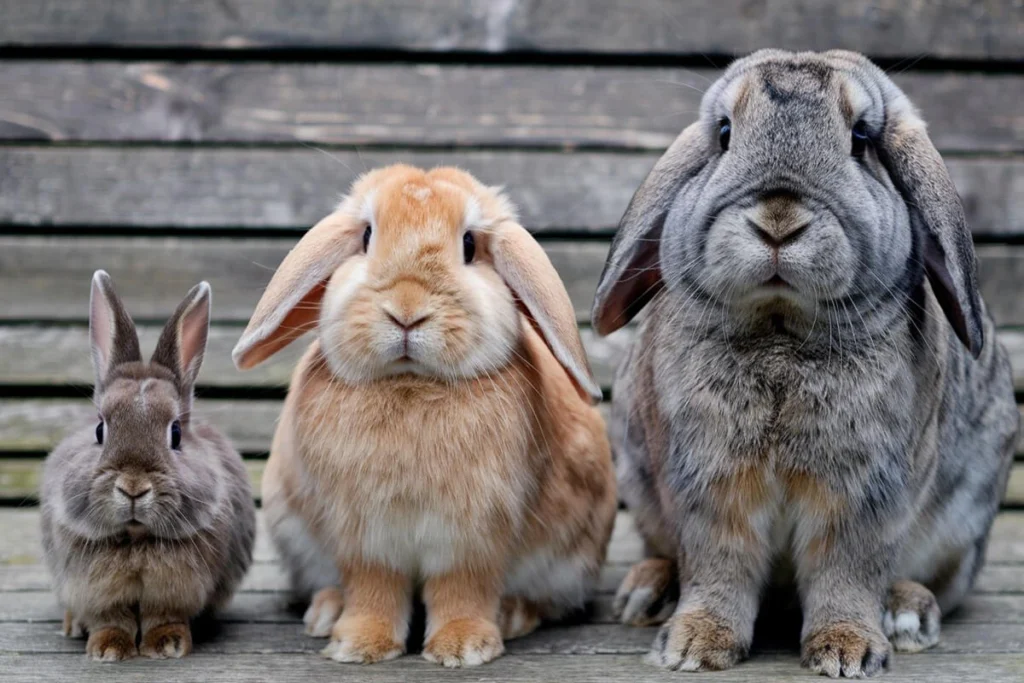
Physical Differences Based on Breeds (Holland Lop, Flemish Giant, Netherland Dwarf)
Not all rabbits look the same, and their physical traits vary significantly depending on their breed. Three popular rabbit breeds—Holland Lop, Flemish Giant, and Netherland Dwarf—highlight these differences.
- Holland Lop: This small, lop-eared breed weighs around 2–4 pounds and has a compact body. Its ears droop down instead of standing upright, giving it a distinct, adorable look. Holland Lops have thick, soft fur and a friendly temperament, making them one of the most popular pet rabbits.
- Flemish Giant: As the name suggests, this breed is enormous, often reaching 15–20 pounds or more. Flemish Giants have long, upright ears, powerful legs, and a muscular build. Despite their size, they are known for their gentle and calm personality.
- Netherland Dwarf: This breed stays tiny throughout its life, usually weighing just 1–2.5 pounds. Netherland Dwarfs have a round face, short ears, and a compact body, making them one of the smallest rabbit breeds. They tend to be energetic and sometimes a bit shy compared to other breeds.
Each breed has its own unique traits, including size, ear shape, and fur texture, showing that rabbits come in a wide variety of appearances.
Differences in Size, Weight, and Fur Type
Rabbits range from tiny, lightweight breeds to massive, heavy ones, and their fur can vary in length, density, and texture.
- Size & Weight: Small breeds like the Netherland Dwarf weigh under 2.5 pounds, while giant breeds like the Flemish Giant can weigh over 20 pounds. Medium-sized rabbits, such as the Mini Rex or Dutch Rabbit, fall somewhere in between, typically weighing 4–6 pounds.
- Fur Type: Some rabbits have short, dense fur, like the Rex Rabbit, which feels like velvet. Others, like the Angora Rabbit, have long, fluffy fur that requires regular grooming. Rabbits with normal fur, such as the Dutch Rabbit, have a smooth, easy-to-maintain coat.
- Ear Shape: Most rabbits have upright ears, but lop breeds like the Holland Lop and French Lop have ears that flop down. Ear shape affects their overall appearance and even their hearing abilities.
These differences in size, weight, fur texture, and ear shape show how diverse rabbits can be. Whether someone prefers a small, playful bunny or a large, calm rabbit, they can find a breed that matches their lifestyle and preferences.
Bunny vs Rabbit: Which Makes a Better Pet?
Considerations for Choosing a Pet (Size, Space, and Maintenance)
Choosing between a pet bunny vs a pet rabbit depends on several factors, including size, space requirements, and maintenance needs. Some breeds stay small, while others grow large, so potential pet owners should consider how much room they have and how much care they can provide.
- Size: Small breeds like the Netherland Dwarf or Holland Lop take up less space and are easier to handle. Large breeds like the Flemish Giant need much more room and a sturdy enclosure to support their weight and size.
- Space Requirements: Rabbits need enough space to hop, explore, and exercise. A small rabbit can live comfortably in an indoor pen with room to move, while larger breeds require bigger enclosures or even a dedicated rabbit-proofed area. Outdoor rabbits need safe, weather-protected hutches with plenty of room to stretch and play.
- Maintenance: Some rabbits require more grooming and upkeep than others. Long-haired breeds like the Angora Rabbit need frequent brushing to prevent matting, while short-haired rabbits require minimal grooming. Additionally, rabbits need daily feeding, fresh water, and regular litter box cleaning to stay healthy.
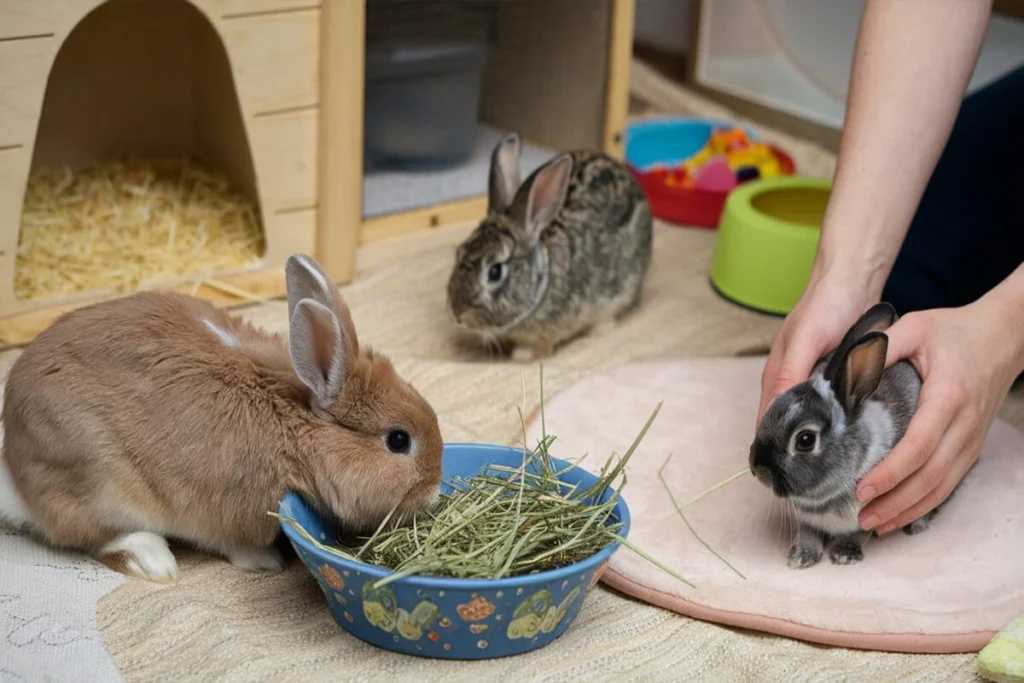
Before getting a rabbit, owners should evaluate their living space, available time, and commitment level to ensure they can provide proper care.
Differences in Behavior: Thumping, Binkying, Digging, and Nesting
Rabbits communicate through body language and unique behaviors. Understanding these behaviors helps owners provide better care and strengthen their bond with their pets.
- Thumping: When a rabbit feels threatened or startled, it stomps its back foot against the ground to warn others of danger. In pet rabbits, thumping can also signal frustration or discomfort.
- Binkying: A happy rabbit expresses excitement by leaping, twisting, and kicking in the air. This joyful movement, called a “binky,” is a clear sign of a content and energetic rabbit.
- Digging: Rabbits have a natural instinct to dig, whether they live in the wild or as pets. In nature, they dig burrows for shelter. Domestic rabbits may try to dig on carpets, in litter boxes, or in their enclosures. Providing designated digging areas or safe toys can help satisfy this instinct.
- Nesting: Female rabbits (does) instinctively build nests, even if they aren’t pregnant. They use hay, fur, and other materials to create a cozy space. If a pet rabbit starts nesting, it could indicate hormonal changes or even a false pregnancy.
Observing and understanding these behaviors allows owners to respond appropriately to their rabbit’s needs and create an enriching environment.
Diet: Importance of Hay, Pellets, and Vegetables
A proper diet plays a crucial role in a rabbit’s overall health. Rabbits have sensitive digestive systems, and their diet must provide the right balance of fiber and nutrients.
- Hay: The most important part of a rabbit’s diet is fresh hay, such as Timothy hay or orchard grass. Hay provides fiber for digestion, prevents obesity, and keeps their constantly growing teeth worn down.
- Pellets: While pellets provide essential vitamins and minerals, they should be fed in moderation. High-quality pellets contain fiber and nutrients, but too many can lead to weight gain and digestive issues.
- Vegetables: Fresh greens like romaine lettuce, parsley, cilantro, and dandelion leaves offer additional vitamins and hydration. Avoid feeding too many sugary vegetables, like carrots, since they can cause digestive problems.
A well-balanced diet ensures that rabbits stay healthy, active, and happy. Owners should provide fresh hay daily, limit pellets, and offer a variety of leafy greens to meet their rabbit’s nutritional needs.
Bunny vs Rabbit: Lifespan and Care Needs
Average Lifespan: 5–12 Years Depending on Breed and Care
Rabbits live between 5 to 12 years, depending on their breed, genetics, diet, environment, and overall care. Some smaller breeds, like the Netherland Dwarf, often live closer to 10–12 years, while larger breeds, like the Flemish Giant, have a shorter lifespan of 5–8 years due to their size and health challenges.
Domesticated rabbits generally live longer than wild rabbits. In the wild, rabbits face predators, harsh weather, and disease, reducing their lifespan to 1–2 years on average. Pet rabbits, on the other hand, live much longer when provided with proper care, a healthy diet, and a safe living space. Spayed and neutered rabbits also tend to live longer because they avoid reproductive-related health issues, such as uterine cancer in females or testicular cancer in males.
By understanding the factors that affect lifespan, owners can take the right steps to ensure their rabbit stays healthy and happy for many years.
Best Practices for Extending a Pet Rabbit’s Lifespan
Providing proper care significantly increases a rabbit’s lifespan. Here are some key best practices to help a pet rabbit live a long, healthy life:
- Balanced Diet: Rabbits need a high-fiber diet rich in hay, fresh vegetables, and limited pellets to maintain proper digestion and prevent obesity or gastrointestinal issues.
- Regular Veterinary Care: Routine checkups help detect health problems early. Rabbits should receive annual vet visits, vaccinations (if applicable), and parasite prevention to avoid illnesses.
- Spaying/Neutering: This procedure reduces the risk of reproductive cancers and prevents aggressive behaviors, leading to a calmer and healthier pet.
- Safe and Spacious Living Environment: Rabbits need ample space to move, hop, and stretch. A cramped cage can cause stress and lead to obesity or joint problems.
- Mental and Physical Stimulation: Providing toys, tunnels, and playtime outside the enclosure keeps rabbits active, preventing boredom and destructive behaviors.
- Proper Grooming: Some breeds, especially long-haired ones like the Angora Rabbit, need frequent brushing to prevent fur matting. Regular grooming also includes trimming nails and checking teeth to avoid overgrowth.
Following these care tips allows rabbits to live longer, healthier lives, free from common health complications.
Housing and Habitat Needs: Burrows, Hutches, and Grasslands
Rabbits thrive in secure, comfortable environments that mimic their natural habitats. Whether living indoors or outdoors, they need adequate space, proper flooring, and environmental enrichment to stay happy and healthy.
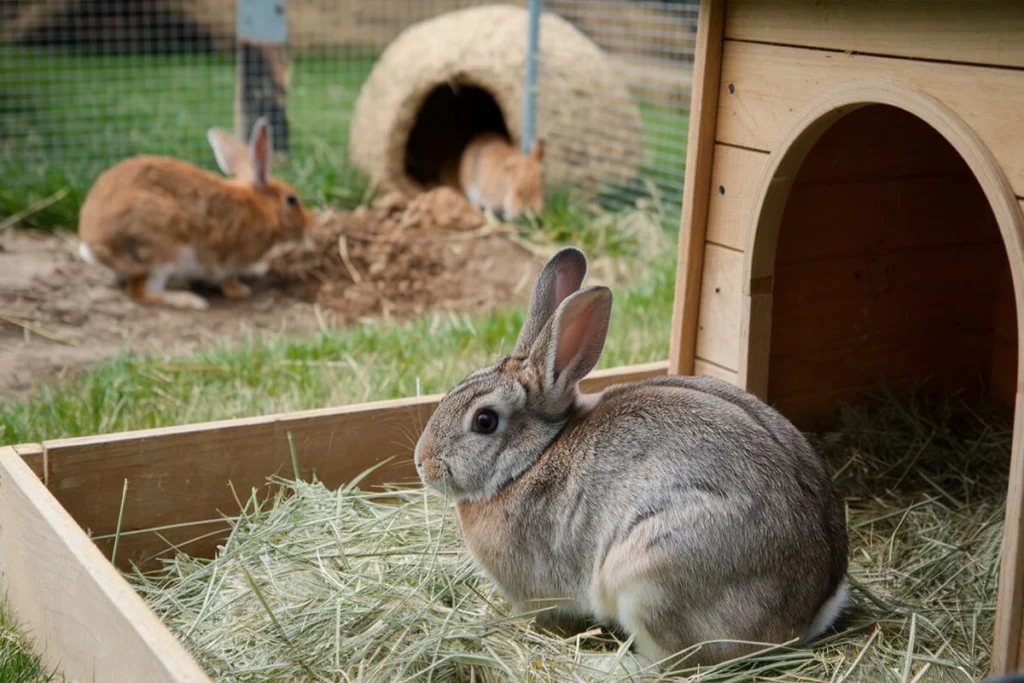
- Burrows: In the wild, rabbits dig underground tunnels called burrows to escape predators, regulate temperature, and raise their young. Domestic rabbits still have a strong instinct to dig, so providing digging boxes or tunnels satisfies this natural behavior.
- Hutches: Outdoor rabbits need sturdy, well-ventilated hutches that protect them from extreme weather and predators. A good hutch should have solid walls, a waterproof roof, and a spacious enclosed run for exercise. Owners must also provide soft bedding, fresh hay, and hiding spots to make the space more comfortable.
- Grasslands & Open Spaces: Rabbits love exploring grassy areas, whether in a secured backyard or a playpen. Supervised outdoor time allows them to graze, run, and exhibit natural behaviors. However, they must always stay in predator-proof enclosures to ensure their safety.
Regardless of where a rabbit lives, its habitat should always be clean, spacious, and enriched with toys and tunnels. A well-designed environment promotes physical activity, prevents stress, and keeps pet rabbits happy.
Fun and Unique Facts About Bunnies and Rabbits
How Rabbits Communicate Through Body Language
Rabbits rely heavily on body language to express their emotions, needs, and warnings. Unlike dogs or cats, they do not make many vocal sounds, so understanding their body movements helps owners interpret their feelings.
- Ear Position: A rabbit’s ears act as emotional indicators. Upright ears show curiosity and alertness, while ears pinned back can signal anger or fear. Some rabbits slightly tilt their ears to the side when feeling relaxed.
- Thumping: Rabbits stomp their back legs when they sense danger or feel irritated. This behavior, called thumping, serves as a warning to other rabbits and is a common sign of stress or frustration in pet rabbits.
- Licking: A rabbit that licks its owner is showing affection and trust. Licking is a grooming behavior that rabbits use to bond with their companions.
- Chinning: Rabbits have scent glands under their chins and rub them against objects (or people) to mark their territory. This behavior is harmless and helps them establish their environment.
- Flopping: A rabbit that suddenly flops onto its side is feeling completely relaxed and safe. This movement might look alarming to new rabbit owners, but it is a sign of contentment.
- Tail Flicking: A quick flick of the tail usually means a rabbit is annoyed or defiant. Some rabbits flick their tails when they don’t want to be picked up or moved.
By observing these behaviors, owners can better understand their rabbit’s mood, comfort level, and communication style, strengthening their bond over time.
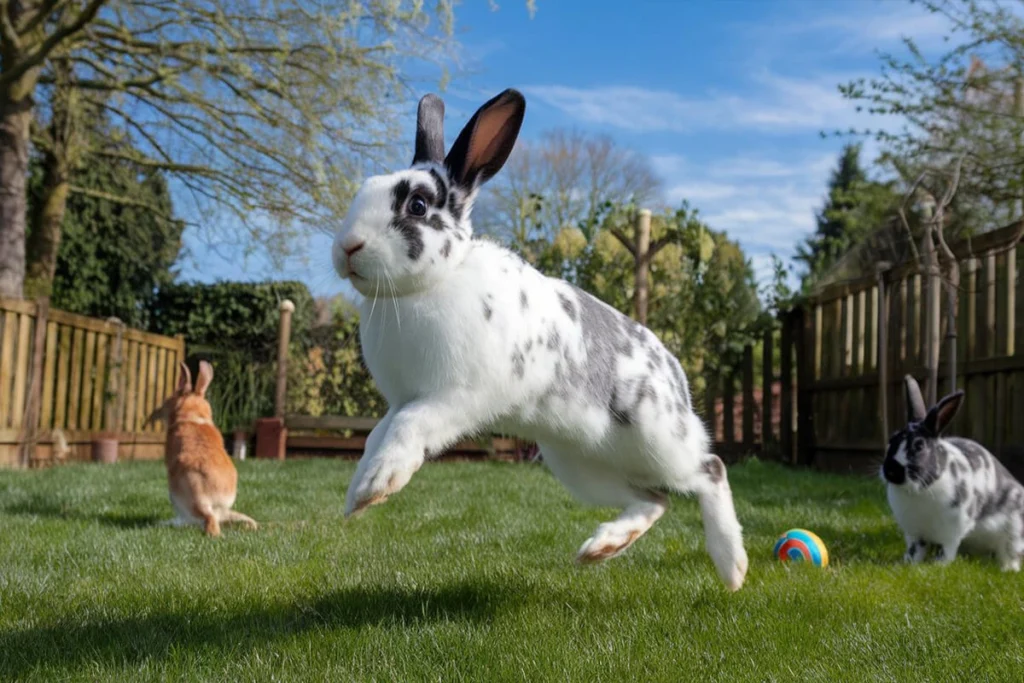
The Fascinating Act of “Binkying” and Why Rabbits Do It
One of the most delightful things a rabbit does is binkying—an energetic jump with a twist or kick in mid-air. A binky is the ultimate expression of joy and excitement in rabbits.
Rabbits perform two types of binkies:
- Full Binky: A rabbit leaps into the air, twisting its body and kicking out its legs. This high-energy movement signals pure happiness.
- Mini Binky (Head Flicks): Instead of a full-body leap, a rabbit might make a quick head flick or small hop. This is a smaller display of excitement but still shows contentment.
Binkying happens when rabbits feel safe, playful, and happy. Rabbits often binky when exploring new environments, after a fun play session, or when interacting with a trusted human or rabbit companion. Seeing a rabbit binky is one of the best signs that it is living a happy, stress-free life.
Myths and Truths About Rabbit and Bunny Intelligence
Rabbits often get underestimated in terms of intelligence, but they are highly capable, curious, and trainable. There are several myths surrounding their intelligence that don’t reflect reality.
Myth: Rabbits are dumb and only act on instinct.
Truth: Rabbits can learn commands, recognize voices, and even solve problems. They are intelligent animals that use both instinct and learning to interact with their environment.
Myth: Rabbits can’t be trained.
Truth: Rabbits are very trainable! Many rabbits learn to use a litter box, respond to their names, and even perform tricks like spinning, jumping through hoops, and pushing objects. Positive reinforcement, such as treats and praise, helps them learn quickly.
Myth: Rabbits have short attention spans and don’t remember things.
Truth: Rabbits have excellent memories and remember both good and bad experiences. They recognize their owners, remember routines, and can hold grudges if they feel mistreated.
Myth: Rabbits don’t form strong bonds with people.
Truth: Rabbits form deep emotional bonds with their owners. They show affection through nudging, licking, and cuddling. Some rabbits even follow their owners around like a dog would.
These truths reveal that rabbits are much smarter and more social than many people assume. With patience and positive interaction, they can become loving, interactive pets who understand and respond to their environment in remarkable ways.
Conclusion
Understanding the bunny vs rabbit distinction goes beyond just words—it helps people appreciate these fascinating animals even more. While “bunny” often refers to a baby rabbit in casual language, “rabbit” is the proper term for the species as a whole. Their scientific classification, breeds, behaviors, and care requirements show how unique and intelligent they are.
Choosing between a pet bunny vs pet rabbit depends on factors like size, space, and maintenance. Small breeds like the Netherland Dwarf are compact and energetic, while large breeds like the Flemish Giant require more space and care. Regardless of breed, all rabbits need a balanced diet of hay, vegetables, and pellets, along with regular veterinary care to ensure a long, healthy life.
Rabbits communicate in fascinating ways. Their body language, binkying, thumping, and nesting instincts help owners understand their emotions and needs. Despite common myths, rabbits are highly intelligent, capable of learning tricks, recognizing their owners, and forming strong bonds. Providing the right habitat—whether indoor hutches, outdoor enclosures, or secure play areas—keeps them safe and enriched.
With proper care, love, and attention, rabbits can live between 5 to 12 years, making them a long-term commitment for any pet owner. Whether calling them a bunny or a rabbit, what matters most is understanding their needs and ensuring they live a happy, healthy life. By learning about the differences and similarities in the bunny vs rabbit debate, owners can make informed choices and build a strong connection with these wonderful animals.
Discover the Giant Angora Rabbit Breed from Here
Pick A Nice and Unique Name for your Fluffy Rabbit Friend From Our 100 names Guide
Find Out More about Pets and Different breeds From HERE!
Discover the Best stuff for your Pet On Pet MD Official
